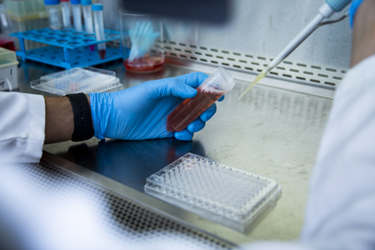ICH Issues Draft Guideline On Viral Safety Evaluation Of Biotech Products
By Tim Sandle, Ph.D.

Viruses threaten to spoil biotechnological products at nearly every manufacturing stage. Viral contamination can affect raw materials, cell culture processes, bioreactor contamination, and downstream processing. It can have the greatest impact on cell lines for biological products derived from cell cultures initiated from characterized cell banks of human or animal origin (e.g., mammalian, avian, insect).1 This is due to the implications for multiple products and the costs associated with discarding cell cultures. It is for these reasons that biotech organizations need to practice viral safety and incorporate viral clearance into their manufacturing processes.2
ICH has released a new draft guideline titled Viral Safety Evaluation of Biotechnology Products Derived From Cell Lines of Human or Animal Origin. The FDA’s version of the document3 closes for public comment on Jan. 14, 2023, and the European Medicines Agency’s version of the document4 closes for public comment on Feb. 10, 2023. 3The finalized version from ICH is expected in November 2023. The core content covers:
- selecting and testing cell lines and other raw materials
- assessing the capacity of the production process to clear infectious viruses
- testing the product at appropriate steps of production.
The guideline seeks to outline harmonized scientific and technical requirements that meet regulatory expectations. The final revised guideline will be adopted by the FDA. This represents the second update to the guideline first issued in 1997 and amended in 1999. The update reflects the evolution of science, technical understanding, and strengthening risk-based approaches. Let’s assess the pertinent points from the guideline.
Viral Risks To Biopharmaceutical Manufacturing
Viruses are composed of DNA, such as herpes viruses, or RNA, such as hepatitis viruses, encapsulated by a protein coat. Viruses can be enclosed in an envelope made of proteins (capsid), carbohydrates, and lipids (enveloped) or alternatively they are non-enveloped. A virus of concern is minute virus of mice (MVM), of which there are different infective species. An example is rodent protoparvovirus, and the primary risk is to mammalian cell culture, especially Chinese hamster ovary cell-based production of biologic drugs. Other examples are vaccinia virus — a large, complex, enveloped virus belonging to the poxvirus family — the release of which is sufficiently serious to lead to facility shutdowns; and rhabdovirus, which more recently has been associated with contamination of some cell cultures like Spodoptera frugiperda Sf21 cells (IPLB-Sf21-AE), used in insect cell culture for recombinant protein production. Other contaminants include reovirus, Cache Valley virus (CVV), and vesivirus isolate 2117.
Sound virus control strategy will have risk assessments and testing plans in place for:
- incoming materials and contaminated excipients, including animal-derived additives, such as bovine serum albumin as many incidents of viral contamination stem from using poorly characterized materials
- contamination of cell lines
- purification and formulation reagents
- presence of impurities leading to viral stability in the process
- failure of controls within a viral secure area
- accidental contamination of a production system
- incomplete inactivation of live viruses used in biopharmaceutical production.
ICH Guideline
The ICH draft guideline sets out to provide guidance for evaluation of viral safety for biotechnological products and the testing required to support this evaluation. This applies to the following:
- products produced from in vitro cell culture using recombinant DNA technologies, including interferons, monoclonal antibodies, and recombinant subunit vaccines
- products derived from hybridoma cells grown in vivo as ascites
- genetically engineered viral vectors and viral vector-derived products (where viruses are removed trough virus clearance). These types of products have been added to the draft guideline. A viral vector is a recombinant virus that can be applied in vivo as a medicinal product or applied ex vivo for different advanced therapeutic applications.
The 65-page detailed revision follows increased regulatory scrutiny of incidents relating to adventitious viruses in manufacturing processes and the need for more accurate laboratory testing. The primary changes relate to:
- advances in manufacturing, both maturation of the industry and the emergence of continuous manufacturing
- new product types that require viral clearance, including genetically engineered viral vectors and viral-vector derived products, and including some updated safety factor calculations
- new analytical technologies such as next generation sequencing
- new virus clearance validation strategies, including an expansion to the risk framework.
Viral Clearance
Helper viruses have been added to the guideline. A helper virus allows an otherwise deficient coinfecting virus to replicate, which aids the spread of viral vectors.5 This is documented in a new case — Case F — which describes when a helper virus is used in production and the verification that viral clearance can be achieved by outlining the use of a relevant model virus for helper virus clearance.
Continuous Manufacturing
Continuous manufacturing, the process whereby a product is made nonstop without any interruptions or pauses between batches, has been added to the guideline. This includes viral safety considerations and when batch process evaluation could be considered sufficient as a scale down model. Specific risks and considerations include:
- longer cell cultivation duration
- possible diversion/segregation impact
- integration of unit operations
- sampling considerations for cell culture
- chromatography steps
- low pH/solvent detergent inactivation
- viral filtration.
The guideline cross-refers to ICH Q13 Continuous Manufacturing of Drug Substances and Drug Products.6
Resin Reuse
The guideline contains updated scientific advice on resin reuse. For protein A affinity capture chromatography, and potentially other media, prior knowledge indicates that virus removal is not impacted or, alternatively, slightly increases for used (e.g., end-of-life) chromatography resin. This means that for regulatory submissions, supporting studies product-specific studies with used resin are not required.
Importance Of NGS Technology
The draft guideline firmly establishes the value of next-generation sequencing (NGS) for viral safety testing, in section 3.2.3. Here, it is stated that “NGS is encouraged as a replacement for in vivo assays.” This is for two reasons:
- the breadth of viruses NGS technologies can detect
- as part of global regulatory objectives to replace, reduce, and refine the use of animal testing.
In section 3, both PCR and NGS technologies are encouraged. NGS differs from quantitative polymerase chain reaction (qPCR) in that, unlike qPCR, NGS does not require prior knowledge of sequence information. NGS has the capability to detect novel genes and it is of a greater sensitivity and scale throughout. In contrast, real-time PCR is arguably easier to use and more tolerant of variable DNA quality. In section 3, molecular methods, with subsections for nucleic acid amplification techniques and NGS, have been added. Whichever option is selected, the testing strategy should be set in place from the outset of new product development.7
Knowledge Capture
Overall, the draft guideline for the viral safety of biotechnology products derived from characterized cell lines of human or animal origin highlights the importance of prior knowledge in designing viral control strategies. This includes the importance of reflecting both scientific literature and marketing application holder-specific experience. Examples include applying knowledge across similar products and undertaking a thorough understanding of the composition of the product intermediate in relation to virus clearance.
References
- Merten OW. Virus Contaminations of Cell Cultures: A Biotechnological View. Cytotechnol. 39(2) 2002: 91–116. doi: 10.1023/A:1022969101804
- Sandle, T. Current Methods and Approaches for Viral Clearance, American Pharmaceutical Review, 2015.
- ICH Q5A(R2) Viral Safety Evaluation of Biotechnology Products Derived From Cell Lines of Human or Animal Origin, 29 September 2022.
- ICH Guideline Q5A(R2) on viral safety evaluation of biotechnology products derived from cell lines of human or animal origin, 10 October 2022.
- Graham BS, Crowe JE, Ledgerwood JE (2007) Immunization Against Viral Diseases. In Knipe DM, Howley PM (eds.). Fields Virology (6 ed.). Wolters Kluwer Health. P. 403.
- ICH guideline Q13 on continuous manufacturing of drug substances and drug products, Step 2b, 29th July 2021.
- Sandle, T. Optimizing a Viral Testing Strategy, American Pharmaceutical Review, 2022.
About The Author:
 Tim Sandle, Ph.D., is a pharmaceutical professional with wide experience in microbiology and quality assurance. He is the author of more than 30 books relating to pharmaceuticals, healthcare, and life sciences, as well as over 170 peer-reviewed papers and some 500 technical articles. Sandle has presented at over 200 events and he currently works at Bio Products Laboratory Ltd. (BPL), and he is a visiting professor at the University of Manchester and University College London, as well as a consultant to the pharmaceutical industry. Visit his microbiology website at https://www.pharmamicroresources.com.
Tim Sandle, Ph.D., is a pharmaceutical professional with wide experience in microbiology and quality assurance. He is the author of more than 30 books relating to pharmaceuticals, healthcare, and life sciences, as well as over 170 peer-reviewed papers and some 500 technical articles. Sandle has presented at over 200 events and he currently works at Bio Products Laboratory Ltd. (BPL), and he is a visiting professor at the University of Manchester and University College London, as well as a consultant to the pharmaceutical industry. Visit his microbiology website at https://www.pharmamicroresources.com.
